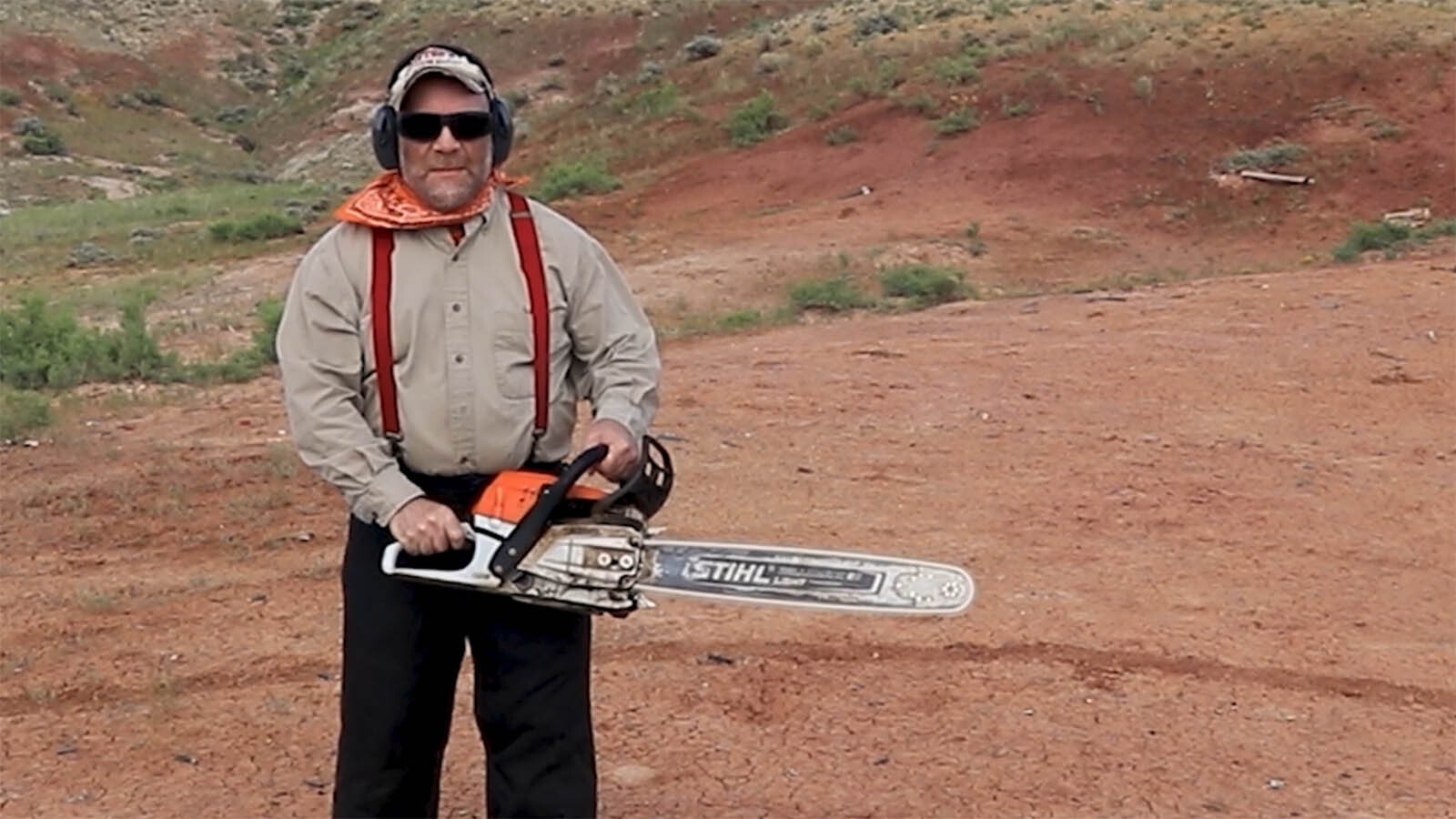By Jake Nichols, Cowboy State Daily
Jake@CowobyStateDaily.com
A recent paper published in the Cambridge University Press touted the largest-known fossil of a penguin discovered by paleontologist Alan Tennyson.
This portly puffin waddled the coastline of New Zealand some 60 million years ago, weighing as much as a refrigerator. The ancient auk was identified as a new species, Kumimanu fordycei, and is thought to be the largest penguin to have ever lived.
By the way, the now-submerged fragmental continent of Zealandia is considered the center of extant penguin diversity, with accumulating fossil evidence supporting hypotheses that penguins as we know them today originated in this part of the world.

Wyoming’s Big Brachiosaur
What’s noteworthy about this discovery halfway across the globe is that in Wyoming, we’re crazy about dinosaurs. Who isn’t?
And frankly, and with all due respect to the scientific community digging up dead birds from the beaches of Otaga, New Zealand, the Cowboy State has dinosaurs that poop bigger than that monster penguin. Literally.
The impressively sized brachiosaur is thought to have supersized scat that weighs in at an estimated 3,000 pounds.
And not only is Wyoming home to the brachiosaur, it’s the biggest one ever found. Well, some of him anyway.
Dubbed “Bigfoot” for obvious reasons, a foot belonging to a close relative of the long-necked, long-tailed brachiosaurus was uncovered in 1998 in the Black Hills region of Wyoming by a team from the University of Kansas.
The brachiosaurus is a genus of herbivorous sauropod dinosaur that lived in North America during the Middle Jurassic, about 150-180 million years ago. It is featured as a gentle lumbering behemoth munching on treetops in the Jurassic Park movie franchise.
“This beast was clearly one of the biggest that ever walked in North America,” said Emanuel Tschopp, a Theodore Roosevelt Richard Gilder Graduate School postdoctoral fellow in the American Museum of Natural History’s Division of Paleontology, in a 2018 press release when the finding was officially recognized.
Discovery Almost Didn’t Happen
Think the Mesozoic Era was long? It took forever to get this foot fossil to a research facility for cleanup and 3D scanning.
In fact, the discovery is 77 years in the making and came close to never happening at all.
Field crews first began exploring Mesozoic formations in the U.S. in the 1870s, starting in southern Utah. University of Kansas alum Elmer Riggs excavated the first brachiosaurus specimen in 1901 in Colorado.
At that time, Wyoming was considered far too north for dinosaurs like the brachiosaurus to have roamed – until a 1941 expedition led by a team from the University of Nebraska found fossils on a remote hilltop in the Black Hills region of northeast Wyoming.
The dig uncovered an extremely large femora belonging to a sauropod, but with summer coming to a close, the site was secured for the winter with every intention of returning.
Then the U.S. entered World War II.
Most field activities were curtailed during wartime. By the time follow-up excavations were organized in the early 1950s, no students or professors could remember exactly where the quarry was located. Records were incorrect (two miles off, it would turn out) and the dig site was nearly lost forever.
Professor Larry Martin at the University of Kansas was a student at U. Nebraska at the time of the original dig in 1941. He organized a new expedition in the 1990s and was able to zero in on the exact location of the famed fossilized femur with the help of a few old-time ranchers in the area.
While it is not the largest brachiosaurus ever found, it is the largest intact foot from the species ever dug up and positively identified.
Wyoming’s Snakey Croc-Faced Sea Monster
Not to be outdone by Bigfoot, College of Charleston geology professor Scott Persons announced the discovery of a bizarre new prehistoric sea monster in September 2022.
Persons labeled his find Serpentisuchops, a biological name translating to “snakey crocodile-face.” It was unearthed from a sulfuric patch of scrubland near Lusk, Wyoming, in 1995.
It took 27 years for the bones to be carefully excavated, cleaned up by a volunteer group of elderly women known as the “Glenrock Bone Biddies,” and finally verified.
This member of the plesiosaur species swam the seas of Wyoming when it was under water some 70 million years ago. Its discovery is significant, Persons says, because this sea creature has both a long neck and a big head.
“It’s an unusual one. It looks like a sea turtle with the shell removed,” Persons commented during a podcast interview with the College of Charleston late last year. “When I was a student, I was taught plesiosaurs come in two basic flavors — one with a really long neck and a tiny head, or the other way around with a short neck and enormous head and crocodile jaws.”
This extraordinarily preserved specimen sports a total of 32 neck vertebrae as well as really long jaws.
“It is unusual to find a plesiosaur with this mix of traits. Very weird,” Persons added. “It might represent a lineage of plesiosaurs that evolved to do something different.”
After studying the fossilized remains, Persons speculates this creature was especially adept at striking out to the side to gulp down a school of prehistoric fish as they passed by.
Today, you can see the unique serpentisuchops sea monster, or the 35% of it unearthed, at the Glenrock Paleon Museum.

T. Rex Tracks In Glenrock
Persons is credited with another fossil first in the Cowboy State. It happened almost by accident when the budding dinosaur hunter was a mere 13 years old. Not even that, truthfully.
His parents fudged the 12-year-old’s application form so he could participate in his first expedition in Wyoming.
During that visit to Glenrock and its Paleon Museum, Persons befriended then-director Sean Smith, who himself made a groundbreaking discovery of a skull of a triceratops in 1994 when he was just 19 years old.
It was a rare find that put Glenrock on the paleontological map and launched the museum.
Smith took notice of Persons’ enthusiasm and asked the kid if he wanted to see something really cool.
Persons remembered, “Sean led me out to a sandstone slope and started brushing away at an indented spot. At first, it looked like a prehistoric pothole. But soon I could see the imprints of three big toes, each with sharp claw tips. It was so cool my jaw dropped.”
It was the footprint of a large carnivorous dinosaur, most likely a Tyrannosaurus rex. And not just one print, but two more, making a left-right-left trackway.
Persons never forgot that experience. Years later, while finishing up his graduate-level study at the University of Alberta, Persons reached out to Smith, pleading with him to pursue formal scientific recognition of the find. That effort was realized in 2016 with the publication of their research in “Cretaceous Research” (V.61, June 2016).
The trackway found in the Lance Formation behind the Paleon Museum is now regarded as the longest sequential set of prints from a tyrannosaurid in the world.
By measuring the distance between the prints and estimating the relative size of the dinosaur—likely an adolescent T. rex, Persons guesses—the research also helped establish that these tyrannosaurs walked faster than previously assumed, according to their stride.
Since the discovery, Sean’s father, Don Smith, confirmed to Cowboy State Daily that the trackway continues on even further. A total of 10 footprints have now been discovered, but private property rights have hampered further exploration.
“We’ll probably never know how far they go,” Smith said.
Persons has come full circle with his love for paleontology. The professor brought a dozen Charleston students to Glenrock last summer for a field trip and plans to do the same this summer with 10 more grad students. He now hopes to unearth the full skull of a triceratops, Wyoming’s official state dinosaur.
“We got super close last year,” Persons said. “An enormous lower jaw, the biggest I have ever seen. We’re hoping to find the rest of him in coming summers.”
Wyoming’s Jurassic Mile
All this dino stuff and we haven’t even mentioned a 1-square-mile stretch of rugged terrain in the Big Horn Basin near Cody.
This 640-acre patch of land in the heart of the Morrison Formation is so exceptionally rich in fossil records it’s been dubbed the “Jurassic Mile.”
In 2019, a 20-year lease was signed by The Children’s Museum of Indianapolis, in partnership with University of Manchester, to allow scientists exclusive access to the dig site that has been victim to private and commercial pillage in decades past.
The massive, $27 million dino dig is expected to eventually uncover hundreds of prehistoric specimens including some never before cataloged. Already, almost 1,000 bones have been discovered.
The exact location of the dig site is kept highly confidential for fear of fossil looters. Reporters headed to the area to cover a news story must agree to switch off geotagging on their phones and avoid taking photographs that feature the horizon.
Pure Bliss: Dig Your Own Dinosaur
Tucked away in the northeast part of Wyoming on the border with Montana is the Bliss Dinosaur Ranch. The 3,000 deeded acres are owned by Frank Bliss, a former Jackson Hole resident and co-founder of Geologists of Jackson Hole. He has a master’s in Geology and a BS in GeoBiology. He’s been a field paleontologist since 1980.
Bliss offers a dinosaur dig, bed & breakfast experience where guests can keep some items they find. “As long as it is not collector, museum-type pieces,” Bliss said.
Bliss is sitting on Hell Creek and Fox Hills sediment—formations marking the latter part of the Cretaceous some 65 million years ago as dinosaurs were slowly dying out. Still, this time period supported around 300 different creatures, 28 species of dinosaurs.
Bliss has amassed an impressive collection of over 10,000 pieces—mostly heavier stuff like teeth and horns that were not easily carried away in the big river flows occurring as ancient oceans drained away westward.
“I get a lot of individual isolated bones because the river was tough on things and broke them up,” Bliss said. “We find teeth and claws and horns, many from triceratops. We do about five digs a year for guests.”





